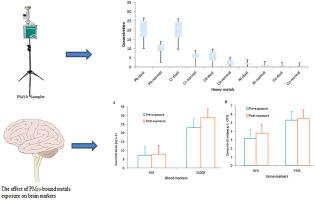Atmospheric Pollution Research ( IF 4.5 ) Pub Date : 2020-08-15 , DOI: 10.1016/j.apr.2020.08.022 Ahmad Badeenezhad , Mohammad Ali Baghapour , Armin Sorooshian , Mojtaba Keshavarz , Abooalfazl Azhdarpoor , Gholamreza Goudarzi , Mohammad Hoseini

|
Epidemiological studies have reported an association between air pollution and central nervous system disorders. However, its biological mechanisms are poorly understood. This study aimed to determine the effect of short-term environmental exposure to PM10 and associated heavy metals on changes in blood and urinary nervous markers in dusty conditions. A total of 44 healthy non-smokers were identified with a mean age of 36 years. Blood and urine samples were taken from these people 24 h before and after the dust storm to measure the biomarkers of the central nervous system. Cortisol, white blood cells (WBCs), neuron-specific enolase (NSE), and S100β were measured as blood markers, while vanillylmandelic acid (VMA) and homovanillic acid (HVA) were tracked as urine markers. These people had 7 h of environmental exposure in dusty conditions. Eleven heavy metals (Al, As, Cd, Cr, Cu, Fe, Mn, Ni, Co, Pb, and Zn) associated with PM10 were measured. The average PM10 concentration on dust days was 3.25 times higher than on normal days (309.81 μg m−3 vs. 86.11 μg m−3). The results of the statistical paired T-test showed that the mean S100β from pre-exposure to post-exposure increased by 5.85 ng L−1 (P ≤ 0.004). The NSE mean of the pre-exposure (3.37 ± 3.48 μg L−1) was significantly different from the NSE mean after exposure)4.15 ± 3.74 μg L−1 ((P = 0.002). The post-exposure WBC mean was 0.59 times higher than that before exposure, albeit not statistically significant (P = 0.269). The mean VMA after exposure increased by 0.55 mg g−1 CRT (Creatinine) compared to that before exposure. This difference was statistically significant (P = 0.000). Changes in S100β after exposure to dust storms had a high correlation with changes in Cr, Pb, and Fe metal concentrations, respectively (r = 0.81, r = 0.72, r = 0. 65). NSE changes were significantly associated with changes in Mn, Cd, and Fe (r = 0.71, r = 0.99, r = 0.71). Heavy metals associated with PM10 can damage neurons and astrocytes, promoting neuropsychiatric disorders in people with exposure.
中文翻译:

调查沙尘暴期间中枢神经系统生物标志物与PM 10结合金属的短期暴露之间的关系
流行病学研究报告了空气污染与中枢神经系统疾病之间的关联。但是,对其生物学机制了解甚少。这项研究旨在确定短期环境暴露于PM 10的影响以及尘土飞扬的环境中血液和尿中神经标志物变化的相关重金属。总共确定了44位健康的非吸烟者,平均年龄为36岁。在沙尘暴前后24小时从这些人那里采集血液和尿液样本,以测量中枢神经系统的生物标志物。皮质醇,白细胞(WBCs),神经元特异性烯醇酶(NSE)和S100β被测量为血液标志物,而香草扁桃酸(VMA)和高香草酸(HVA)被跟踪为尿标志物。这些人在多尘的环境中暴露了7小时。测量了与PM 10相关的11种重金属(Al,As,Cd,Cr,Cu,Fe,Mn,Ni,Co,Pb和Zn)。平均PM 10尘埃浓度比平日高出3.25倍(309.81μgm -3与86.11μgm -3)。统计学配对T检验的结果表明,从暴露前到暴露后的平均S100β增加了5.85 ng L -1(P≤0.004)。暴露前的NSE平均值(3.37±3.48μgL -1)与暴露后的NSE平均值显着不同4.15±3.74μgL -1((P = 0.002)。暴露后WBC平均值是0.59倍尽管没有统计学意义(P = 0.269),但高于暴露前的水平;暴露后的平均VMA增加了0.55 mg g -1CRT(肌酐)与暴露前相比。这种差异具有统计学意义(P = 0.000)。暴露于沙尘暴后,S100β的变化分别与Cr,Pb和Fe金属浓度的变化高度相关(r = 0.81,r = 0.72,r = 0. 65)。NSE的变化与Mn,Cd和Fe的变化显着相关(r = 0.71,r = 0.99,r = 0.71)。与PM 10相关的重金属会损害神经元和星形胶质细胞,从而促进接触者的神经精神疾病。



























 京公网安备 11010802027423号
京公网安备 11010802027423号